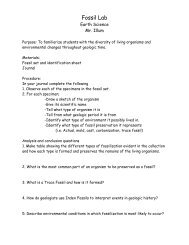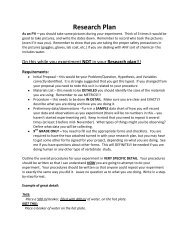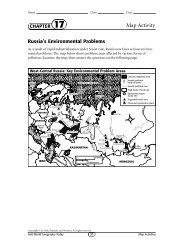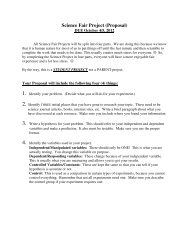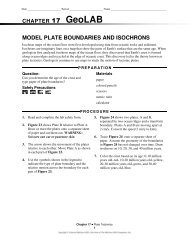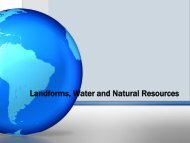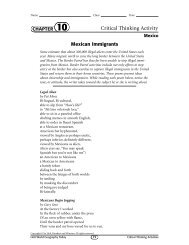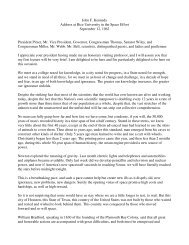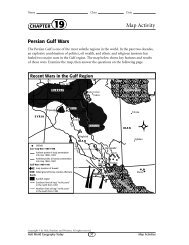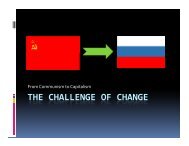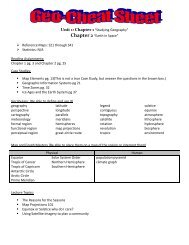Waves on a Spring Lab - legacyjr.net
Waves on a Spring Lab - legacyjr.net
Waves on a Spring Lab - legacyjr.net
You also want an ePaper? Increase the reach of your titles
YUMPU automatically turns print PDFs into web optimized ePapers that Google loves.
Name Date Class<str<strong>on</strong>g>Waves</str<strong>on</strong>g> <strong>on</strong> a <strong>Spring</strong><strong>Lab</strong> PreviewDirecti<strong>on</strong>s: Answer these questi<strong>on</strong>s before you begin the <strong>Lab</strong>.1. Why should you wear goggles when performing this lab?Hands-On Activities2. How will you use yarn in this lab?<str<strong>on</strong>g>Waves</str<strong>on</strong>g> are rhythmic disturbances that carry energy through matter or space.Studying waves can help you understand how the Sun’s energy reaches Earthand sounds travel through the air.Copyright © Glencoe/McGraw-Hill, a divisi<strong>on</strong> of the McGraw-Hill Companies, Inc.Real-World Questi<strong>on</strong>What are some of the properties of transverse and compressi<strong>on</strong>al waves <strong>on</strong> a coiled spring?Materialsl<strong>on</strong>g, coiled spring toycolored yarn (5 cm)Goalsmeterstickstopwatch■ Create transverse and compressi<strong>on</strong>al waves <strong>on</strong> a coiled spring toy.■ Investigate wave properties such as speed and amplitude.Safety Precauti<strong>on</strong>sWARNING: Avoid overstretching or tangling the spring to prevent injury or damage.Procedure1. Study the data table <strong>on</strong> the next pagebefore you begin the lab.2. Work in pairs or groups and clear a place<strong>on</strong> an uncarpeted floor about 6 m ✕ 2 m.3. Stretch the springs between two people to thelength suggested by your teacher. Measurethe length.4. Create a wave with a quick, sideways snapof the wrist. Time several waves as theytravel the length of the spring. Record theaverage time in the data table in the Dataand Observati<strong>on</strong>s secti<strong>on</strong>.5. Repeat step 4 using waves that have slightlylarger amplitudes.6. Squeeze together about 20 of the coils.Observe what happens to the unsqueezedcoils. Release the coils and observe.7. Quickly push the spring toward your partner,then pull it back.8. Tie the yarn to a coil near the middle of thespring. Repeat step 7, observing the string.9. Calculate and compare the speeds of thewaves in steps 4 and 5.<str<strong>on</strong>g>Waves</str<strong>on</strong>g> 5
Name Date Class(c<strong>on</strong>tinued)Hands-On ActivitiesData and Observati<strong>on</strong>sWave DataLength of stretched spring toyAverage time for a wave to travelfrom end to end—step 4Average time for a wave to travelfrom end to end—step 5Trial 1 Trial 2 Trial 3 Trial 4C<strong>on</strong>clude and Apply1. Classify the wave pulses you created in each step as compressi<strong>on</strong>al or transverse.2. Classify the unsqueezed coils in step 6 as a compressi<strong>on</strong> or a rarefacti<strong>on</strong>.3. Compare and c<strong>on</strong>trast the moti<strong>on</strong> of the yarn in step 8 with the moti<strong>on</strong> of the wave.Communicating Your DataWrite a summary paragraph of how this lab dem<strong>on</strong>strated any of the vocabulary wordsfrom the first two secti<strong>on</strong>s of the chapter. For more help, refer to the Science SkillHandbook.Copyright © Glencoe/McGraw-Hill, a divisi<strong>on</strong> of the McGraw-Hill Companies, Inc.6 <str<strong>on</strong>g>Waves</str<strong>on</strong>g>




